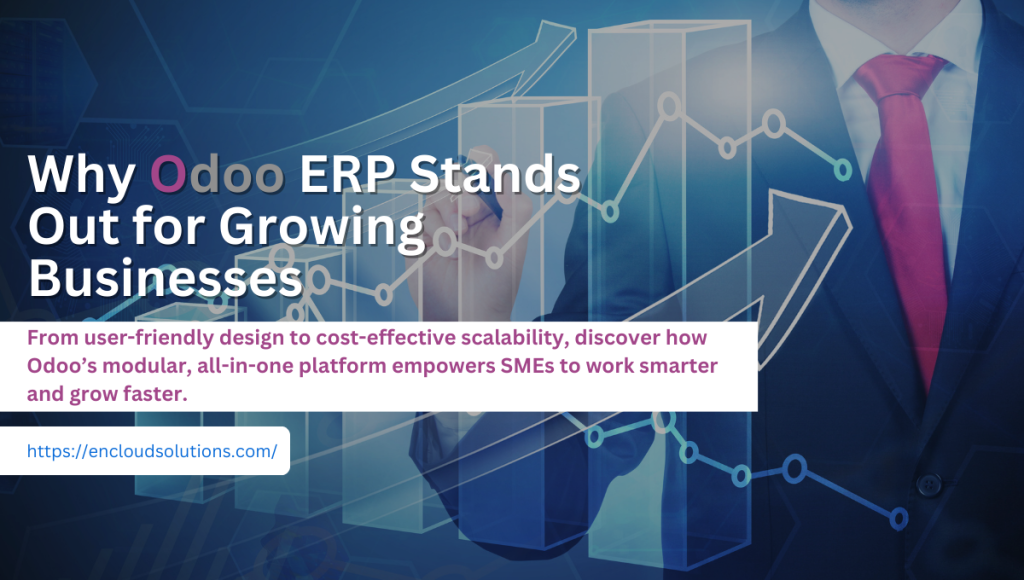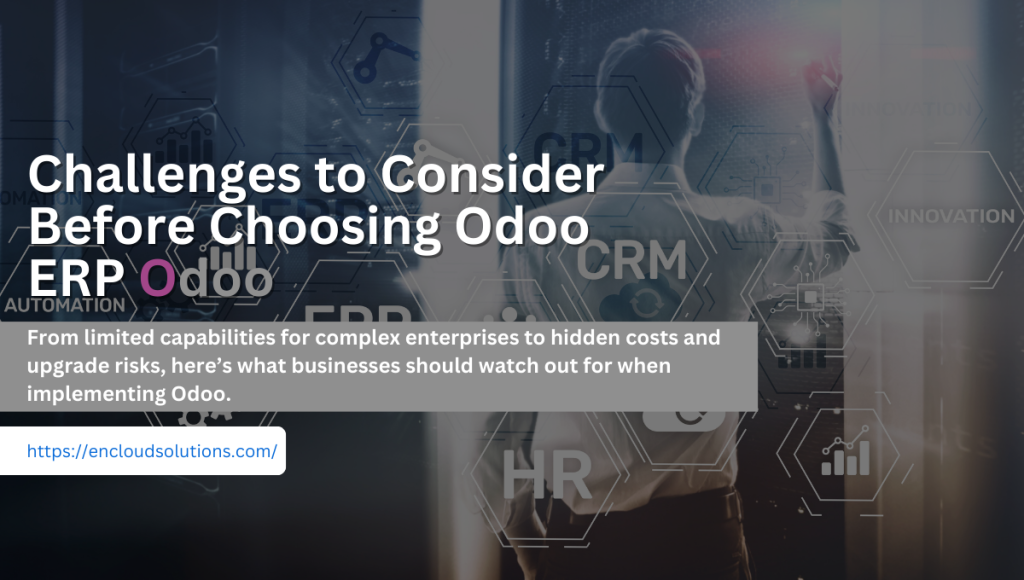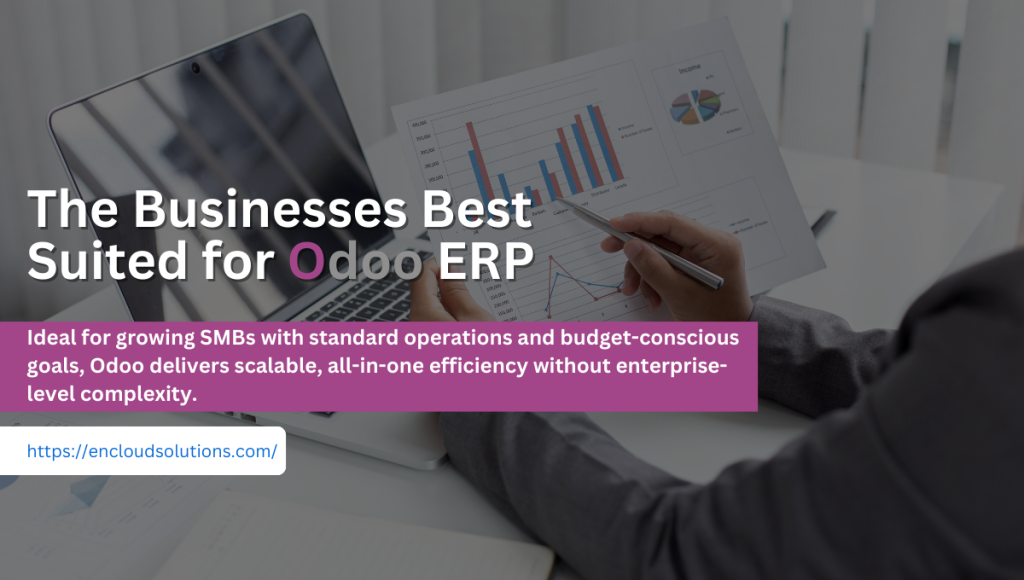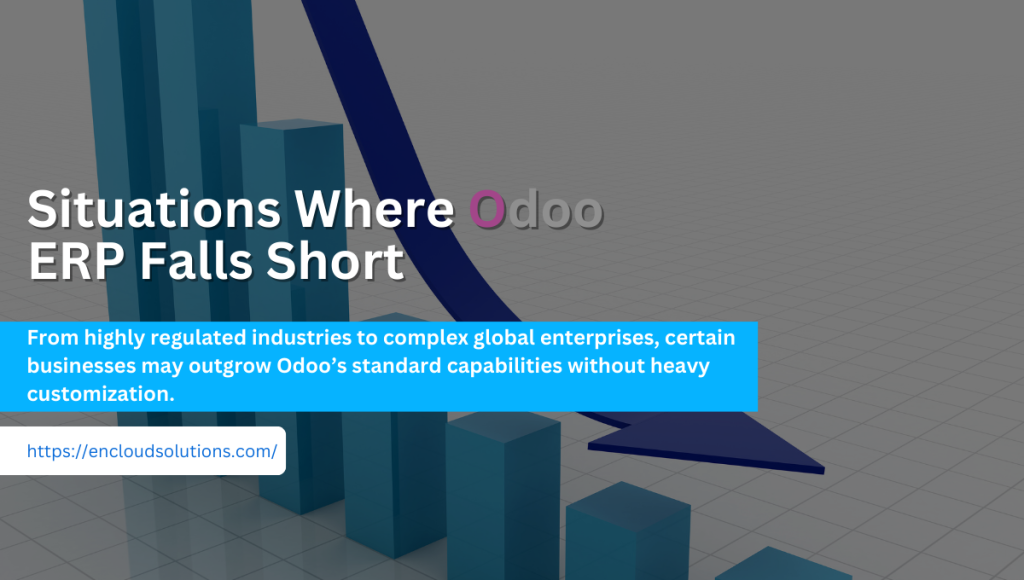
Odoo is an open-source ERP suite offering modular business apps (CRM, accounting, inventory, manufacturing, etc.) in one interface. Founded in 2005, Odoo has grown rapidly; the company recently closed a €500M investment round led by CapitalG (Alphabet’s fund) and Sequoia, valuing it at €5B. Today, Odoo serves 13M+ users worldwide. This combination of community-driven innovation, modern UI, and strong financial backing has made Odoo an attractive ERP option for many small and mid-sized businesses. If you’re researching before implementation, reading an honest Odoo ERP review can help you understand its performance, usability, and long-term value for small businesses.
ERP systems integrate core functions across a company. Odoo’s modular design lets you start with only the apps you need (for example, only Sales or Inventory) and add more modules later. This avoids the high upfront cost of full-suite systems. Its all-in-one architecture means data is centralized: for example, updating inventory immediately affects sales and accounting, eliminating manual syncing. In practice, Odoo offers a clean, responsive web interface that most users find easy to learn. Many companies explore Odoo advantages and disadvantages before adoption to decide if the platform suits their workflows and budget.
In short, Odoo empowers companies to streamline operations without heavy overhead: “Odoo provides a unified environment for managing various business functions efficiently.”
Also Read: Zoho One Vs Zoho CRM Plus
Advantages of Odoo ERP
Here are a few key advantages of deploying the Odoo ERP system:
Understanding Odoo advantages can help you see how it supports growth and scalability for small and mid-sized enterprises.
1) User-Friendly, Modern Interface
Odoo’s web-based UI is praised for its clean, intuitive design, which helps non-technical staff onboard quickly. Users can navigate dashboards and forms without extensive training. For example, the Odoo workspace (shown above) lets you access Sales, Inventory, Accounting, etc., from one menu, a big step up from juggling multiple standalone tools.
2) Low-Code Customization (Odoo Studio)
Odoo includes a built-in configurator called Odoo Studio that requires little or no coding. With drag-and-drop tools and simple rules, business users can customize forms, workflows, reports, and approval processes on the fly. This “low-code” approach means you can adapt Odoo to your needs (adding fields, automating tasks, and creating new forms) without hiring a developer. You still have the option to code if needed, but many routine customizations are easily done by a power user. This flexibility is one of the strongest points often highlighted in Odoo pros and cons comparisons.
3) Modular, Scalable Architecture
You can adopt Odoo one module at a time. Start with a core app (like CRM or Invoicing) and add more as you grow. This modularity makes Odoo highly scalable: you only pay for and learn the parts you need now, then seamlessly enable new modules later. In practice, companies often begin with basic accounting or sales and later add Inventory, Manufacturing, or e-commerce. The architecture is designed so that adding modules doesn’t require expensive re-implementation. In short, Odoo “can evolve with your business needs” because of this plug-in structure.
4) Integrated “All-in-One” Solution
Unlike cobbling together separate apps, Odoo unifies CRM, sales, purchasing, inventory, accounting, marketing, HR, and more on one platform. This means data flows between departments: for instance, invoicing is automatically tied to sales orders and accounting, reducing errors. As the TargetIntegration partner blog notes, Odoo’s suite “centralizes data and processes” so you don’t need multiple disconnected tools. For a small business owner, this reduces IT complexity and makes reporting much easier. When evaluating Odoo ERP advantages and disadvantages, businesses often praise its integration while noting the setup effort required.
5) Strong Open-Source Community & Apps
Being open-source, Odoo has a vast global community of developers and partners constantly improving it. Odoo’s official app store now lists 40,000+ community apps (modules and add-ons), the largest ecosystem of business apps. In practice, this means if you need a niche feature (say, specific local tax reporting or industry-specific forms), there’s often already a community module for it or a developer who can build it. This continuous innovation ensures Odoo keeps up with new business trends. In short, the “community-driven development” model provides regular updates, new extensions, and peer support.
6) Rapid Growth & Strong Backing
Odoo’s recent funding round (led by CapitalG and Sequoia) and 40%+ annual growth reflect market confidence. The capital infusion accelerates product development, support infrastructure, and global expansion. It also means Odoo S.A. has stable finances behind the project. As Odoo’s press release highlights, the €500M investment underscores Odoo’s leadership position in the SMB software ecosystem. For users, this translates to ongoing improvements (e.g., new features in each version) and peace of mind that the platform will continue to evolve.
7) Cost-Effective for SMEs
Without hefty licensing fees, Odoo is generally far cheaper than traditional ERP. The Community Edition is free to use, and even the paid Enterprise Edition charges a modest per-user fee with all-in-one pricing. In fact, as one Odoo partner blog notes, “Odoo eliminates licensing costs associated with proprietary software,” lowering the total cost of ownership. You still pay for hosting and support, but compared to SAP or Oracle, the sticker price is much lower. This makes Odoo especially appealing to cost-conscious small and mid-sized companies. Overall, these Odoo advantages make it a strong ERP contender for growing companies looking to centralize operations efficiently.
8) Great Entry-Level ERP
For companies moving from spreadsheets or basic accounting tools, Odoo is an excellent first ERP. It offers a gentle learning curve relative to enterprise giants. Odoo provides a unified system that replaces multiple disconnected tools, which often results in quick efficiency gains and fast ROI. For example, a finance manager gains real-time dashboards instead of waiting for manual reports. Odoo’s design “wins over customers across more than 100 countries,” in part because its suite is easy to use. In practice, many startups and SMBs find they can implement Odoo faster and train staff more easily than with older ERP systems.
Also Read: Odoo ERP Tutorial for Beginners

Disadvantages of Odoo ERP
Odoo ERP has various advantages, but every pro also has a con. Similarly, Odoo ERP also has disadvantages, which we are discussing here:
Before investing, it’s essential to review Odoo disadvantages to get a realistic view of its limitations and potential challenges.
1) Not Built for Very Complex Enterprises
Odoo’s simplicity is a double-edged sword. Large, multinational companies or those with highly complex processes may find Odoo lacking. For example, Odoo’s core accounting does not include an automated global consolidation or a unified multi-entity chart of accounts. Its inventory module lacks advanced valuation (no built-in LIFO/FIFO rotation options) and lot/serial tracking needed in some industries. Likewise, very advanced manufacturing (like engineer-to-order or heavily automated lines) often needs third-party MRP add-ons.
In short, businesses requiring sophisticated ERP features (global compliance, extensive manufacturing/engineering controls, complex multi-currency support) may find themselves pushing Odoo beyond its limits. This often leads to costly custom development or even having to replace Odoo later. In most Odoo pros and cons analyses, scalability and enterprise limitations are frequently mentioned drawbacks.
Figure: Companies with complex manufacturing needs may find Odoo’s standard MRP module insufficient. It handles basic BOMs and work orders but lacks advanced ETO routing, scheduling, and quality controls.
2) Customization & Upgrade Risks
Because Odoo is open-source and highly customizable, heavy tailoring can become a headache. Every time you customize the code, you risk making future upgrades harder. As one comparison notes, “Odoo is highly customizable… the downside is customization can make future upgrades challenging, as each update may require significant changes.”
In practice, this means that if you commission lots of bespoke features, each new Odoo release might break them. You’ll need skilled developers to reapply or fix customizations during upgrades, a process that consumes time and money. It also creates vendor lock-in at the developer level: your system knowledge resides with whoever built it. Without careful planning, an open-source advantage can become an upgrade liability.
3) Hidden Costs Over Time
While Odoo’s entry cost is low, the total cost of ownership can rise. The Community edition is free, but most organizations soon add paid apps, users, or the Enterprise plan. Odoo’s pricing scales with modules and users. For instance, to use advanced features (like certain accounting or manufacturing tools), you may need the paid Enterprise edition. Partner implementation and customization fees can also add up.
As one analyst warns, “the cost of customization, implementation, and ongoing support can add up over time.” Small firms may find themselves continually budgeting for new modules or consultants. In short, without strict oversight, the system that started “free” can end up costing a lot more. Many reviews summarizing Odoo advantages disadvantages mention that while it’s affordable upfront, customizations may increase long-term costs.
4) Dependence on Partners and IT Resources
Success with Odoo often hinges on having experienced help. Unlike mature vendors, Odoo itself provides limited direct support (especially on the free edition). Implementations typically require certified Odoo partners or internal IT experts. As a result, if you don’t have a skilled integrator, the project can stall. One review notes that “partnering with an experienced Odoo implementation partner can be beneficial” because internal teams may lack expertise.
In practice, poorly chosen consultants can lead to bad customizations or missed requirements. Moreover, open-source ERPs can drain a company’s IT budget: maintaining and customizing Odoo requires ongoing developer time. Companies must either build that skill in-house or pay agencies, both of which offset initial cost savings.
5) Learning Curve and Change Management
Even though Odoo’s UI is user-friendly, implementing any new ERP demands change management. Employees need training to move from spreadsheets or legacy tools. As TargetIntegration points out, new ERP systems always involve a “learning curve” that can temporarily reduce productivity. Additionally, Odoo’s wealth of features means the system can be overwhelming at first. Organizations should plan for user training and gradual rollout to avoid resistance. Understanding both Odoo advantages and disadvantages helps organizations plan for smoother adoption and avoid costly surprises.

Who Benefits Most from Odoo?
Odoo is tailored for small and mid-sized businesses with relatively straightforward processes. It excels when your company meets most of the following criteria:
For a detailed insight into how different businesses experience it, checking an Odoo ERP review can be very helpful.
1) SMB Scale (e.g., $1M–$100M Revenue)
Odoo thrives in companies without enormous IT budgets or global complexity. It’s designed for growth-stage companies. Indeed, analysts note Odoo is a good fit for small businesses and startups with simple requirements.
2) Standardized Operations
Businesses that have standard workflows, basic manufacturing, wholesale/distribution, retail, services, or e-commerce will find Odoo fits well. For example, an online retailer can use Odoo’s e-commerce, inventory, and accounting modules together, enjoying real-time stock updates. In essence, if your processes don’t require heavy customization or unusual functionality, Odoo is a strong match.
3) Cost-Conscious Budgets
If minimizing spending matters, Odoo’s low entry price is compelling. Its open-source model “eliminates licensing costs,” so you avoid the five- or six-figure upfront fees charged by SAP/Oracle. Many SMBs pick Odoo as a cheaper alternative to proprietary ERP.
4) E-Commerce/Retail Focus
Online sellers and retailers often benefit. Odoo’s native e-commerce app seamlessly integrates with inventory, sales, and CRM, providing an efficient end-to-end solution. This makes it popular for companies growing from simple online stores or POS systems into a unified ERP.
5) Growing, Not Yet Global
Odoo works best for businesses planning to scale organically. Firms adding locations or entities slowly will appreciate being able to start small and grow modules. If you foresee aggressive M&A or expansion into dozens of countries, you’ll need to carefully vet Odoo’s fit and possibly augment it with specialized systems.

When Odoo May Not Be Right
While Odoo has many strengths, it isn’t ideal for every situation. Examples of poor fits include:
1) Large, Complex Enterprises
If you’re a multinational with thousands of employees, complex intercompany accounting, and global compliance needs (e.g., a regulated pharma or defense firm), Odoo will likely frustrate you. Tier-1 ERPs like SAP S/4HANA or Oracle Cloud provide deep features for these cases. In contrast, Odoo would require so many custom add-ons that it could break down.
2) Highly Regulated Industries
Companies in sectors like aerospace, defense, or healthcare often need certified compliance modules (FDA, ITAR, HIPAA, SOX, etc.). Odoo’s out-of-the-box functionality does not include most of these controls. You would have to rely on third-party apps or custom development to meet regulatory requirements, which adds risk and cost.
3) Advanced Manufacturing or ETO
Engineer-to-order (ETO) manufacturers or firms with very advanced MRP needs may find Odoo’s manufacturing module too basic. While Odoo handles standard BOMs, routings, and work orders, it lacks built-in support for complex scheduling, quality workflows, product lifecycle engineering, or industry-specific processes. In practice, heavy manufacturing companies often adopt a specialized system instead (e.g., Infor, Plex, or Microsoft D365 for manufacturing).
5) Full Multi-Company/Global Operations
If your business requires true multi-entity consolidation, automatic intercompany transactions, or heavy multi-currency consolidation, Odoo’s standard tools are limited. It does support multiple companies and currencies to an extent, but without advanced automation. For instance, automated period closing across divisions or regulatory filings for many countries would likely be manual or require add-ons.

Key Considerations Before Choosing Odoo
Before you commit to Odoo, keep the following in mind:
1) Long-Term Fit
Evaluate whether Odoo can scale with your future needs. It’s excellent now, but consider where you’ll be in 5–10 years. If you anticipate rapid growth into complex areas (advanced manufacturing, multiple countries, public compliance), plan how Odoo would handle that. Remember that heavy customization to make up for limitations can complicate future upgrades.
2) Total Cost of Ownership (TCO)
Don’t be lured in by “free community” alone. Calculate the full 3–5 year cost: include Enterprise licenses (if needed), additional modules, hosting, implementation partners, training, and maintenance. As one analyst notes, “while the software itself may be free, businesses will incur significant costs for development, customization, and ongoing maintenance.” Create a realistic budget for upgrades and new apps.
3) Implementation Partner
The success of Odoo often hinges on your consultant or internal team. Choose an experienced Odoo partner (or hire skilled Odoo developers). Their expertise will help avoid common pitfalls like over-customization or data migration errors. Check partner references and industry experience. A good partner will also help plan upgrades so you can incorporate customizations in a modular way.
4) Internal Resources & Change Management
Even with Odoo’s ease of use, implementing ERP requires internal effort. Ensure your team has capacity for data migration, training, and change management. Odoo’s community and documentation are helpful, but plan for user training early. Also, review your IT infrastructure: whether you host on-premises or use Odoo.sh/cloud, confirm you have the servers and network to run the system smoothly.
5) Evaluate Alternatives
Finally, compare Odoo with other ERPs. In some cases, a slightly more expensive solution might save headaches later. Weigh Odoo’s flexibility and cost against specialized solutions that come with more out-of-the-box functionality for certain industries. Informed decision-making is key.

Summing Up
Odoo ERP offers a compelling package for many SMB owners: a modern, integrated platform that is easy to adopt and initially inexpensive. However, it’s always wise to compare Odoo ERP advantages and disadvantages before making your final choice. Its clean interface, low-code configurator, and vast app ecosystem let growing companies quickly move beyond spreadsheets or fragmented tools. Strong community support and recent investor funding suggest that Odoo will continue to improve at a fast pace.
However, it’s not a one-size-fits-all cure. Organizations with complex or highly regulated operations should carefully assess whether Odoo’s breadth matches their needs. Hidden costs, upgrade complexities, and support dependencies must be planned for. Weigh Odoo’s advantages against its limitations: for the right company, typically a small-to-mid-sized firm with standard processes, Odoo can deliver major efficiency gains. But for enterprises with sophisticated requirements, it may only serve as a stopgap.
In the end, consider Odoo as a powerful entry-level ERP: if your business fits the profile, it can streamline operations and reduce costs. Ultimately, every company should weigh Odoo pros and cons to decide if it’s the right fit for their operational needs. As one Odoo investor put it, the platform’s “powerful and easy-to-use suite of apps has won over customers” worldwide. Just be sure to partner with experts, plan for scale, and understand the long-term investment before getting started.
Also Read: Odoo ERP for Manufacturing
FAQs
What is the ERP Odoo system?
An ERP (Enterprise Resource Planning) Odoo system is a way to manage various aspects of a company in an integrated way by providing a wide range of business applications.
What is the disadvantage of using Odoo?
The disadvantages of utilizing the Odoo ERP system include a) Not built for very complex enterprises, b) Customization & upgrade risks, c) Hidden costs over time, d) Dependence on partners and IT resources, and e) Learning curve and change management.
What are the benefits of using Odoo?
The key benefits of leveraging Odoo ERP include a) User-friendly, modern interface, b) Low-code customization (Odoo Studio), c) Modular, scalable architecture, d) Integrated “All-in-One” solution, e) Strong open-source community & apps, f) Rapid growth & strong backing, g) Cost-effective for SMEs, and h) Great entry-level ERP.


